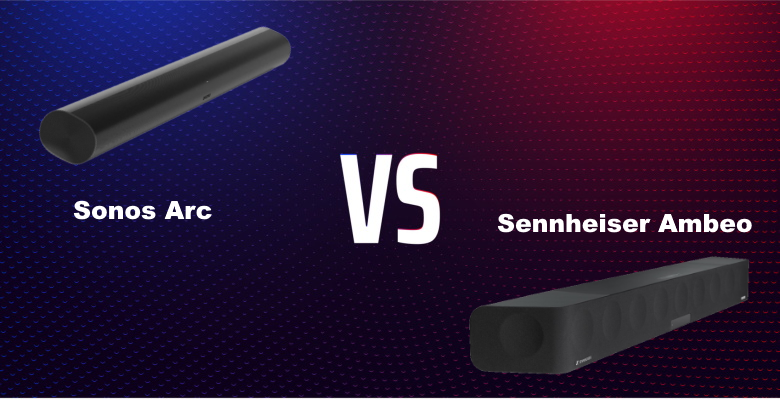When you are ready to step up to the next level of home entertainment, there are a few soundbars out there that are great options. If you’ve narrowed your search down to the Sonos Arc vs Sennheiser Ambeo, you know these are both great.
In this article, you will learn about the features that set these two home entertainment soundbars apart and why we think the Sonos Arc is an overall better buy for most home entertainment rooms (>>> Check the current price on Amazon).
Sonos Arc vs Sennheiser Ambeo Side by Side:
| Sonos Arc | Sennheiser Ambeo | |
|---|---|---|
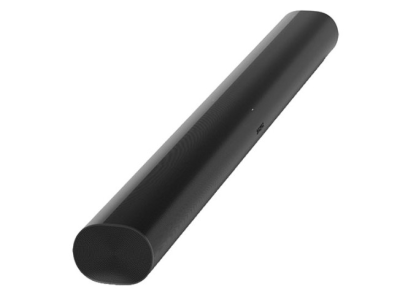 | 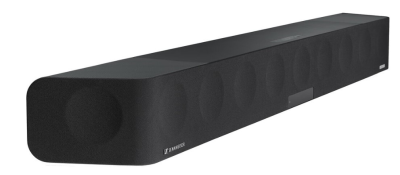 |
|
| Power (Watts) | 110W | 500W |
| Connectivity Options | HDMI | Wi-Fi, Bluetooth, HDMI |
| Subwoofer | No | No |
| Dimensions (inches) | 3.4 x 45 x 4.5 | 49.8 x 6.73 x 5.31 |
| Price | Find on Amazon B&HPhotoVideo | Find on Amazon B&HPhotoVideo |
Comparing the Appearance
The first thing you notice about the Sonos Arc is the simplistic ovoid shape. Provided your television is at least 45 inches wide, the soundbar practically disappears when it’s mounted on the wall. The Sennheiser Ambeo has a geometric circles-and-squares look that makes it stand out from the TV rather than blend in. While the aesthetic is really up to the consumer, the sleek profile of the Arc will be less of a statement, regardless of the decor of your entertainment space.
Both units have a similar layout, with input and output plugs in the back of the unit. They are both designed for wall-mount or tabletop placement. Neither product includes the mount, and at this time, only the mounts sold by the manufacturer will work. The Arc wall mount retails around $120, while the Ambeo wall mount can be had for about half that.
The Arc is available in black or white so you can tailor the look to your home. The Ambeo soundbar is only available in black. While black is usually an attractive option, there are situations where white may look better, and it’s always good to have options.
Sonos Arc
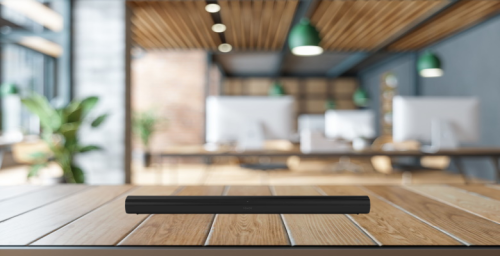
Sonos Arc
Pros
- Incredibly lifelike 3D sound
- Adds just the right amount of bass for action movies
- Attractive design and color options increase the perceived value
- Backward and forward compatible with Sonos speakers and subwoofers
Cons
- Lakes legacy support for DTS:X, which creates connectivity issues for many users
- Does not include full app support for Android users
Comparing the Speakers
The job of a soundbar is, of course, to produce excellent sound. You won’t be disappointed in the quality of these products.
The Arc contains 11 speakers in total to the 13 in the Ambeo. The speakers are not equivalent, however. The Arc uses eight powered elliptical woofers, including two that are up-firing. These speakers handle mostly mid-range, provide bass frequencies, and improve high-frequency sound. Three silk-dome tweeters provide high-frequency sound and improve vocal quality.
The Ambeo pushes mid-range tones and bass through five long-throw woofers. Two up-firing drivers provide excellent bass response and realism, while the five aluminum dome tweeters handle high-frequencies.
Both soundbars perform remarkably regardless of movie, TV, or music being played. These are top-tier soundbars, after all, so it’s not a surprise they both sound excellent. For movies and television, the Arc seems to provide a fuller, richer, more immersive experience, though because it lacks true surround sound rear speakers, the rear sounds are noticeably lacking. When playing music, particularly anything with a thick bass line, the lack of a subwoofer is obvious. But when you are watching an action movie, the depth of bass sound the soundbar makes is surprising without rattling the walls.
The Ambeo sounds unbelievable, particularly when playing Dolby Atmos 3D sound. The realism is shockingly good, making horror movies all the more terrifying. You really get a great sense of distance and movement in sound with the Ambeo. Bass is delivered solidly, though it takes a little adjusting to get it to sound right. As with the Arc, the lack of rear speakers creates a noticeable difference when listening to sound effects coming from overhead or from behind.
Overall, the Sonos Arc had better sound reproduction and quality. Voices sounded as accurate or better than the Ambeo, which is significant considering the price difference. The Ambeo didn’t justify the extra cost in the enjoyment of movies, television, or music versus the Arc.
Sennheiser Ambeo
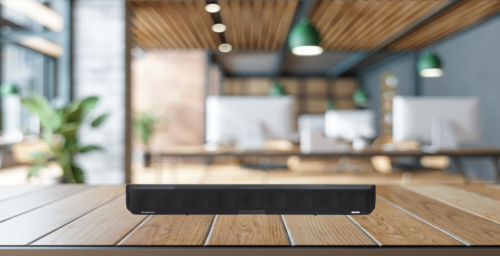
Sennheiser Ambeo
Pros
- Easy to connect blu-ray players and gaming systems to the soundbar
- Powerful speaker arrangement provides excellent 3D sound and loud music playback without distortion
- Fully functional app for all smartphone users
Cons
- Looks large and clunky when hung on a wall. Not everyone has a table under the TV
- Requires some fine tuning for different types of listening experiences, particularly on bass frequencies in more intimate spaces
- Really expensive
Connectivity and Playback Features
The Ambeo soundbar offers support for Dolby Atmos, DTS:X, and MPEG-H technologies, giving you the ability to convert stereo sound into a realistic 3D environment. The Sonos soundbar is considered “future-ready”, which means it does not support older technology like DTS:X. Instead, it solely uses Dolby Atmos. This can create some playback issues when you are watching blu-ray discs.
There are also some connectivity issues when using various gaming systems that can be worked around, but will take more effort. By adjusting settings, it is possible to get your Playstation 4 Pro working with the Sonos Arc, but it simply isn’t as simple to do as with the Sennheiser Ambeo.
App Control
The Sennheiser app unlocks the true potential of the soundbar. The app is available in full form for iOS and Android. Once you become familiar with the app, you’ll learn how to use the settings to tailor the soundbar to your room and listening preferences. The Sonos Arc uses the brand-new S2 platform, and includes a revolutionary app that is available for Android, iOS, and iPadOS. The app does not support TruePlay on Android, a disappointment when it comes to fine-tuning your system easily.
Overall, the Senheiser app is a better, more polished product that offers easy ability to make settings changes and get the sound just how you want it. The new Sonos app is much better than the old S1 version and offers some of the key features you would expect. The lack of full compatibility with Android continues to be a source of irritation for ANdroid-only households. The easy solution is to ask a friend to come over who uses an iOS smartphone and program the speakers.
Why The Sonos Arc is the Right Soundbar
Some of the lack of compatibility and the irritating app may be a cause for concern for some buyers, overall, your money is going to go farther with the Sonos Arc as a standalone entertainment solution for the average room. It provides an excellent mix of volume, clarity, and realism while looking like a seriously high dollar soundbar. Beat for beat, it keeps up with the Ambeo in almost all situations.
Sonos should improve their app and make features like TruePlay available to Android users. Legacy input users looking for DTS:X support out-of-the-box should understand the process of getting the Sonos to work. The good news here is that when you upgrade your gaming system or video playback methods, your Sonos Arc is already compatible. For the money, the Sonos Arc is simply a better buy. Check the related comparison between Sennheiser AMBEO Plus and Sonos Arc.
Conclusion
Our pick between the Sennheiser Ambeo and the Sonos Arc largely comes down to sound quality and price, and in this head-to-head, the Arc just sounds phenomenal for the price, while the Ambeo sounds at least as good as you would expect for what it cost. You will love the theater-quality 3D sound these soundbars provide, and either makes an excellent purchase you won’t regret, but to get the best soundbar for the future, we recommend the Sonos Arc (>>> Find on Bhphotovideo).
